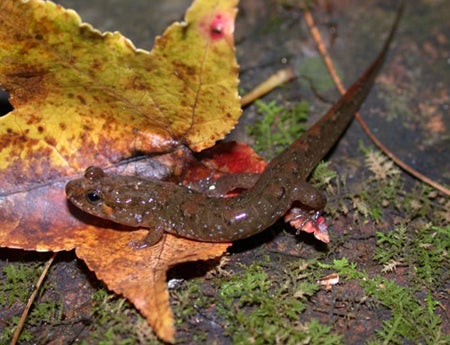SCIENTIFIC NAME:
Desmognathus ocoee (Nicholls)
OTHER NAMES:
Originally described as the Mountain Dusky Salamander (Desmognathus ochrophaeus) and later elevated to a separate species on the basis of genetic differentiation (Tilley and Mahoney 1996).
STATUS:
Common, but extremely limited in distribution in northeastern portion of Southwestern Appalachians. Until recently (1996), Alabama populations were considered to be mountain dusky salamander, D. ochrophaeus. Known from fewer than 10 localities in Alabama. MODERATE CONSERVATION CONCERN.
DESCRIPTION:
A small, four-legged salamander about 1.6 inches long with a generally flattened body. The tail is triangular in cross-section. Like other members of its genus, the Ocoee Salamander typically has a reddish to light orange stripe running from the base of the eye to the corner of the mouth. Ground color is highly variable depending on location, ranging from nearly black to brown to yellow and orange. Most individuals have a strongly visible pattern of alternating dots running the length of the back. These dots may occasionally merge in some individuals to form a rough-edged stripe. The belly is often mottled with variable colors similar to those on the back. Larva are small, generally around 3/4 inch in length, with five to seven pairs of alternating spots down the back and white gills.
DISTRIBUTION:
Restricted to two distinct range portions: one occurring across the southern Appalachian highlands of northern Georgia, extreme western North Carolina, and portions of eastern Tennessee, the other occurring across the southern Cumberland Plateau in northeastern Alabama and a few counties surrounding Chattanooga, Tennessee. Known from only a few locations in northeastern Alabama in Jackson and Dekalb counties.
HABITAT:
Wet areas with moist substrates, most commonly around small streams and seeps. Despite being more terrestrial than some other members of its genus and occasionally found in moist forests far from water, moisture is always a key requirement. May also be found in and around crevices on wet, shaded cliffs (Huheey and Brandon 1973). Individual salamanders are most often encountered under rock cover or beneath/within fallen logs, occasionally occurring in moss mats on the forest floor. Individuals emerge from cover objects at night to forage.
LIFE HISTORY AND ECOLOGY:
Due to its rarity in Alabama, few studies of the life history and ecology of the Ocoee Salamander have occurred in the state. In North Carolina, however, Ocoee Salamanders mate in the late summer months into early fall, with females depositing eggs hanging from the roofs of small crevices in moss mats, under streamside rocks, and under or within rotting logs near streams and in exceedingly moist forest. Females attend egg clutches until hatching, which occurs after an incubation period that varies widely with geography from 30-70 days. Larvae metamorphose after a period of 7-10 months and reach sexual maturity 2-3 years following metamorphosis. Adult Ocoee Salamanders have small home ranges and are known, like many other salamanders, to be fiercely territorial.
BASIS FOR STATUS CLASSIFICATION:
Ocoee Salamanders inhabit an extremely restricted range in Alabama across northeastern portions of the state. Within this range, fewer than ten populations of Ocoee Salamanders are known to exist. Since Ocoee Salamanders require mature forest and healthy stream habitats with abundant moisture, undeveloped or unaltered habitat types across the extent of their range in Alabama are limited, as well.
REFERENCES:
Huheey, J.E. and R.A. Brandon. 1973. Rock-Face Populations of the Mountain Salamander, Desmognathus ochrophaeus, In North Carolina. Ecological Monographs. 43:59-77.
Tilley, S.G. and M.J. Mahoney. 1996. Patterns of Genetic Differentiation in Salamanders of the Desmognathus ochrophaeusComplex (Amphibia: Plethodontidae). Herpetological Monographs. 10:1-42.
AUTHOR: Walter H. Smith – University of Alabama, Alabama Partners in Amphibian and Reptile Conservation






